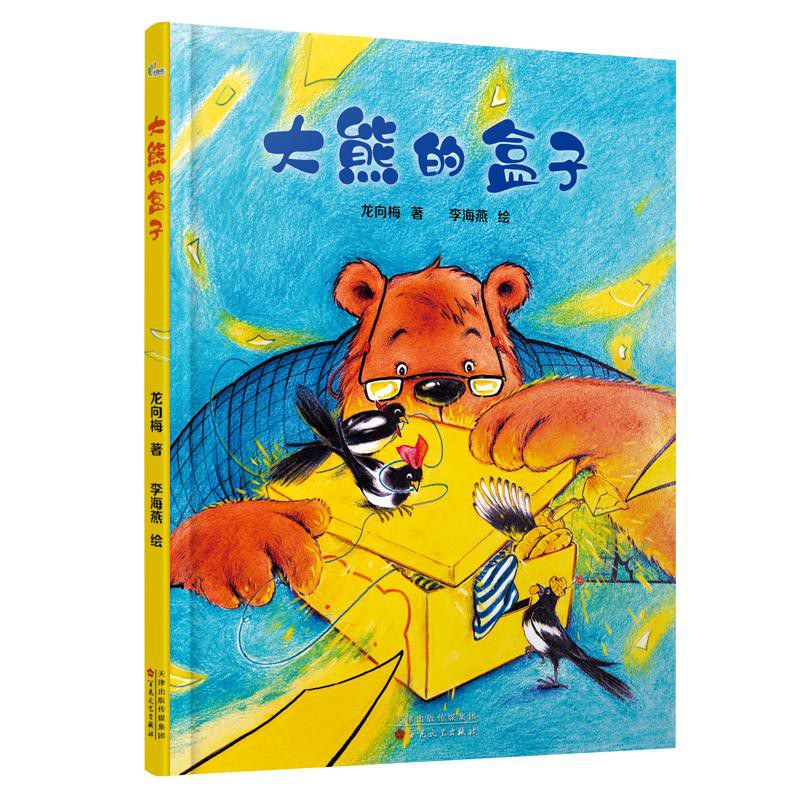——Review of the original picture book “Big Bear’s Box”
“Big Bear’s Box,” a heartwarming fairy tale collaboration between author Long Xiangmei and illustrator Li Haiyan, explores a crucial topic in our aging society: the gradual loss of memory in the elderly, while understanding, care, and family affection endure. In the story, Big Bear, a grandfather, sees his yellow box of memories gradually shrink, but his bond with his children remains as unbreakable as a black box. The concise yet poetic text, combined with the delicate and vivid narrative images, weaves together this deeply resonant story, immersing the reader in the characters’ inner worlds and allowing them to experience the enduring family love hidden behind memories.
The bear in the book reminds me of Li Haiyan’s illustrations for Peng Yi’s story, “The Bear Guardian.” Her illustrations often oscillate between reality and fantasy, seamlessly integrating them through meticulous background details and vivid character expressions, making the stories visually captivating. In “The Bear’s Box,” she focuses on the characters’ emotional expressions, resulting in even more vivid and detailed character designs. This is especially true when depicting the bear’s frustration and pain as he gradually loses his memory. Through his eyes and gestures, readers can sense a warm yet poignant flow of emotion.
Her graphic narrative technique is also more sophisticated. Starting with the title page, the illustrations quietly reveal the story’s clues: Big Bear bids farewell to his son and his family. The trunk, overflowing with gifts from his father, is filled with heartfelt gifts, and the various hats he has given his family become crucial symbols of memory. In the following scenes, the illustrator skillfully depicts Big Bear’s gradual loss of memory through the shifting colors and elements. Big Bear’s reunions with friends and fishing trips gradually reveal his forgetfulness. The recurring yellow box, a symbol of memory, with its contents floating in mid-air, symbolizes the inevitable dissipation of memory. Big Bear attempts to hold onto these precious memories by sorting through the box, but the process is difficult and heartbreaking.
In the scene depicting the reunion between Big Bear and his son, Abu, Li Haiyan employs striking contrasts of color to convey the shifting emotions. Initially, Abu returns home, but his father no longer recognizes him. This sequence is dominated by a monotonous yellow, conveying a sense of loneliness and helplessness. Later, Abu decides to take his father to the sea, and the colors along the way become increasingly vibrant, conveying the relaxation and nourishment they find in nature, and the rediscovery of the warmth and connection of family. When Big Bear finally recognizes Abu, the shift in the image is both subtle and immediate. Against a completely blank background, their colors return to their most original and vibrant colors, creating a powerful emotional impact. This contrast not only captures Big Bear’s emotional ups and downs, but also allows the viewer to clearly sense the contrast between memory loss and the rekindling of family bonds.
The book also employs numerous symbolic symbols, cleverly echoing the text. The most iconic is, of course, the yellow memory box. It appears throughout the book, its gradual shrinkage symbolizing the loss of memory. On the back endpapers, the yellow box is neither completely closed nor fully open, perhaps suggesting that some memories stubbornly persist, even as the majority inevitably dissipates.
The recurring presence of hat-wearing magpies adds a touch of humor and lightheartedness to the story, bringing a touch of joy to the somewhat weighty subject matter and balancing the emotional depth with the playfulness of the story. These magpies also carry clear symbolic meaning, as they symbolize good fortune in Chinese culture and also suggest companionship and hope. These magpies appear repeatedly throughout the story, often helping Big Bear straighten out his memories. They accompany Big Bear, flying around in hats likely woven by him, as if helping him retrieve lost memories.
Furthermore, elements such as fishing scenes, hats, lines, food, and forests frequently appear in the story, symbolizing various fragments of life in memory. Water imagery also permeates the story, especially in the final journey to the sea. Although Big Bear and Abu may not actually reach the sea, the imagery of lakes and rivers also symbolizes the flow and dissipation of memory.
“Big Bear’s Box,” presented as a fairy tale, easily evokes memories of conditions like Alzheimer’s. Big Bear’s gradual memory loss closely resembles the symptoms of real-life Alzheimer’s patients—they gradually forget their closest relatives and even the smallest details of daily life. Long Xiangmei skillfully conveys the plight and emotional upheaval of memory loss in old age through her fairy tale, while Li Haiyan’s masterful visual storytelling makes this all more tangible and moving.
Notably, the author doesn’t directly mention Alzheimer’s disease, but instead gently presents the symptoms of this type of memory loss to young readers, allowing them to gain a deeper understanding of memory and family bonds through the story. This gradual loss of memory can also be caused by brain damage, the normal aging process, or other conditions such as Alzheimer’s. Therefore, this work isn’t limited to Alzheimer’s disease, but rather encompasses a wide range of memory deterioration scenarios, evoking special care and understanding for the elderly.
For young readers, this touching picture book may leave a lasting and beautiful image: the yellow box of memory is gradually shrinking, but the black box of family affection is always there, and you always have the opportunity to open it in the right way.
Cherish the present and remember to store more treasures in the black box!
Ajia written in Beijing on September 13, 2024
